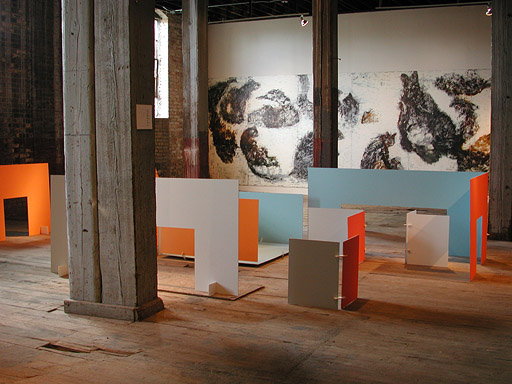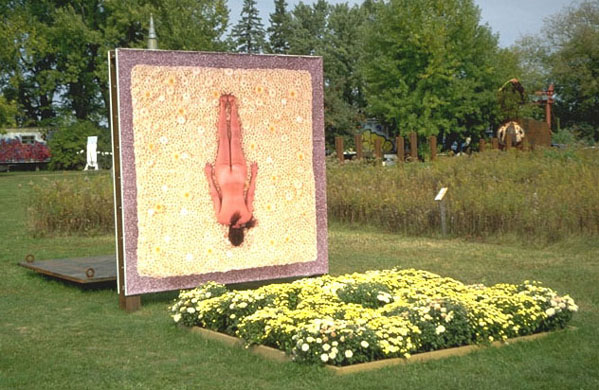Jean Humke
Minnesota artist Jean Humke is a sculptor, installation and environmental artist, curator, and community organizer. She spoke to arts writer Michael Fallon about her ideas on community in relation to art.


Minnesota artist Jean Humke is a sculptor, installation and environmental artist, curator, and community organizer. She spoke to arts writer Michael Fallon about her ideas on community in relation to art:
Question: “Community” is a complicated term. What is your understanding of the term and how it applies to the artistic process?
Jean: I guess I equate community with context. I see it as working in a context, a history, being informed by what’s there or what’s around us–as opposed to working in isolation or working alone.
Q: Can you give an example of work that fits into a context?
Jean: In all of my work I go to place that I’ve been invited or am drawn to, and I listen, orally and visually, to what is wanted or needed. Often it has to do with uncovering what’s invisible or unspoken, or it’s giving some kind of image or voice to what is there but isn’t being seen. A good example of this is when I work with youth. In one project [an N.E.A.-funded residency among the Oneida Indian tribe in Oneida, Wisconsin], I worked with high school kids in an area that’s a big tourist trap. And the kids had concerns about this–the loss of green space, condominiums moving in, and so on. In fact, in the local community everyone talks about this issue, but no one wants to do anything about it. Making art publicly, then, becomes a way to have a conversation about things that are important but people aren’t talking about. It’s not necessarily a way for a community to locate answers, but to come together and ask questions. I think this is a valid activity.
Q: Do you have strong ideas about the relationship between arts and community? How does “Preseason” [a show Humke curated that runs at the Soap Factory May 17-June 21, 2002] reflect your ideas? And how does your art do so?
Jean: I believe it is the role of the artist to be many things, not just one thing…. The beauty of art is it can take many paths. I don’t think all artists need to be working in the way that I do. I think in “Preseason,” I’m realizing that I’m part of an international community of artists, not only a local community…. There are medium to small-sized art communities all over the world, and many of these communities are eager to establish curatorial and artistic connections with other places in the world. The “Preseason” show reflects some of that. Here, I’m working with artists in Minneapolis, and Brooklyn–I think of Brooklyn as a kind of a small town, even though it’s part of New York–and then Helsinki. Also, all three artists [Sean Connaughty of Minneapolis, David Lowe of Brooklyn, and Miika Nyyssonen of Helsinki] are from smaller towns originally, and then moved into medium-sized communities. As I’m like that myself, we had that in common–where we were raised and then chose to live–and I feel that this is reflected in the work.
Q: The work in “Preseason” is quite different from work I’ve seen of yours. What do you look for when curating a show?
Jean: This is a hard question to answer. I am looking for . . . a questioning, which is similar to what I’m interested in. Asking questions as opposed to getting answers. I’m looking for someone who is working through something. And I’m interested in wonder–the activity of wonder. I feel there is not enough opportunity in the world today for people to wonder in a positive, beautiful way. . . . And curiosity. I’m looking for curiosity. I’m looking for these things through visual exploration, and when I look and talk to people about their work.
Q: How do you generally coordinate wearing the different hats of the artist, the curator, and the community organizer?
Jean: I do see them as hats, so for example when I’m curating I won’t show my work in the show. When I’m working in a specific community with a bunch of kids or a tribe or whatever, I’m interested in focusing on their vision and teasing from them the picture they have of their community that isn’t being seen. In my own specific work I’m very much plumbing the depths of myself and asking my own questions in a public context and with the help of other people usually. There is a group dynamic consistent in all three activities that I’m interested in, and that I think is very important. I think they all have to do with a group process that incorporates both being shoved into people and holding hands at same time, and with the dynamic back-and-forth between those things–of challenging and nurturing, whether it is myself, or a group of artists I’m curating, or a group of kids I’m working with. And it goes both ways, that’s very important.
Q: How are venues like No Name and Franconia [where Humke is regularly involved in projects] important to a community of artists? What role do they serve in the community at large?
Jean: Well, at both places the main thing is that they are testing grounds, messy places. And they are experimental and unpredictable, and mistakes happen there. I think that it’s a radical thing in this day and age and in this art world to have these types of places. They are huge services to artists and to viewers for demystifying or explaining or showing a wider range of what the artistic process is–which includes sketching, in the larger sense of the word, and it includes experimenting and fluidity and making mistakes. And editing. And I think it’s important for the public to see all of those things, not just finished products.